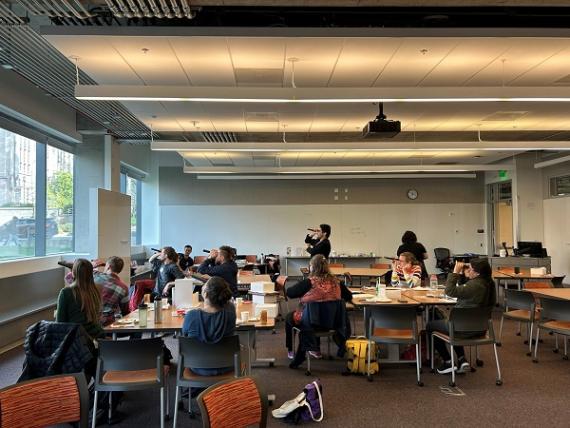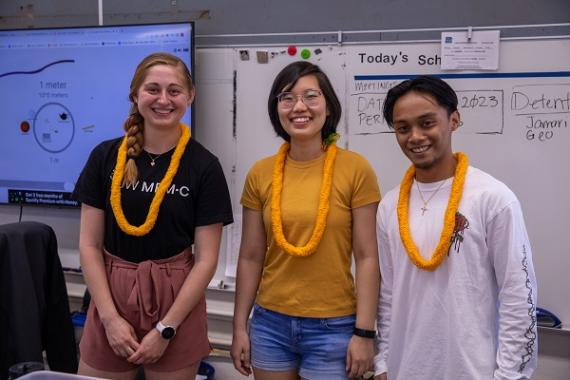Six years ago, in 2017, UW’s Molecular Engineering Materials Center was awarded $16 million to forge “new materials-research frontiers through team-based development of novel electronic and photonic materials relevant to future high-tech applications.” MEM-C is one of only nineteen Materials Research Science and Engineering Centers (MRSECs) nationwide and is funded by the National Science Foundation (DMR-1719797).
Led by UW Chemistry Professors Daniel Gamelin and Xiaosong Li, MEM-C is driven by the Center’s two interdisciplinary research groups (IRGs). MEM-C’s interdisciplinary “moonshot” approach to materials science has taken use-inspired basic research to new heights.
Defects in nanostructures are the focus of MEM-C’s IRG-1 and their research has developed new optoelectronic materials that exhibit quantum-cutting solar spectral conversion based on ytterbium (Yb3+)-doped lead-halide perovskite semiconductor nanocrystals. These new materials hold promise for use as photonic spectral conversion layers that can increase the efficiencies of single-junction solar cells.
Work by MEM-C’s IRG-2 led to the discovery that monolayer WTe2 may be the first topological excitonic insulator, having helical edge states protected by the formation of a correlated excitonic state in the bulk. Results published in Nature Physics show that unusual properties of the bulk monolayer at low doping imply the presence of equilibrium excitons that condense at low temperature.
In addition to research, the Center’s outreach has also been stellar. MEM-C’s Education Director Danica Hendrickson led a workshop this February for secondary STEM teachers designed to facilitate connections between MEM-C research and the Next Generation Science Standard.
Overarching goals included: conveying for teachers the impact of cutting-edge, interdisciplinary materials research on society and the natural world, and informing about potential STEM careers related to materials research. The workshop was also sponsored by UW's Clean Energy Institute (CEI) and UW's NSF Center for Integration of Modern Optoelectronic Materials on Demand (IMOD).
Eight teachers attended, including a previous participant in MEM-C's Research Experience for Teachers (RET) program. All attendees received Washington State STEM Clock hours, a small stipend, and spectrometers to use for MEM-C activities related to light (pictured below). MEM-C Graduate Student Chaman Gupta (UW MSE PhD student in the Pauzauskie group) facilitated a MEM-C activity for teachers and a “Meet a Materials Scientist” presentation.

Every summer, MEM-C hosts their “NanoCamp” on campus at UW Seattle, to middle school students over the course of an entire week.
This year, MEM-C and their Partnership for Research and Education in Materials (PREM) partners at the University of Hawai’i at Mānoa Materials Research and Education Consortium (MRE-C) worked to bring MEM-C’s NanoCamp curriculum to Hawai’i. The MEM-C group included faculty (Daniel Gamelin, Xiaosong Li, Lilo Pozzo, and Brandi Cossairt) and seven UW PhD students who instructed NanoCamp, including MEM-C Education and Training Fellows Sam Tetef (top photo, left) and Sarah Zeitler and other students from the UW RSO, STEM Pals.
“NanoCamp is a great hands-on learning experience that shows students that nanoscience is not just something in a Marvel movie to make superheroes but about the true superpowers of science. Students get to become nano scientist for the day!” –Daniella Griffay, teacher, Radford High School
Over the course of three days, MEM-C instructed NanoCamp modules at five schools and interacted with over 600 middle school and high school students. MEM-C also trained UH MRE-C undergraduate students in the curriculum.
In Hawai’i, rather than provide a weeklong camp at each school, the host teachers selected from a list of NanoCamp modules that best fit their classroom needs. One of the middle school sessions even included a Q&A with MEM-C Executive Director of Education and Outreach, Xiaosong Li, and MRE-C Director Godwin Severa (pictured below).

Along with hosting NanoCamp this summer, MEM-C will host their largest summer participant cohort yet, including three UW students from the Materials ALVA program (Alliances for Learning and Vision for Underrepresented Americans), eight Research Experiences for Undergraduates (REU) students from colleges around the country, two secondary schoolteachers, and seven students from MEM-C’s collaborators at UH and the University of Central Florida under their NSF awards through the PREM research program.
Also, this summer, the Center will hold their annual All Hands meeting at UW’s Pack Forest Conference Center in July and will be actively continuing research under their current NSF award and await the outcome of their proposal for an additional six years and another $18 million in funding. To keep up with the Center’s activities, visit their website www.uwmemc.org.
Top picture: Sam Teft (MEM-C Education and Training Fellow, UW Physics PhD Student), Grace Song (UW STEM Pal, UW Physics PhD Student), and Kendall Lorenzo (UH MRE-C Undergrad) at a NanoCamp at Ilima Intermediate School in Ewa Beach, Oahu in March 2023.
Second picture: MEM-C PhD Student Chaman Gupta from UW’s Department of Materials Science and Engineering demonstrates how to use handheld spectrometers to secondary schoolteachers and at a workshop in February 2023.
Third picture: UW MEM-C Executive Director of Education Xiaosong Li and UH MRE-C Director Godwin Severa leading a Q&A session the University Laboratory School in Honolulu, HI in March 2023.
Below: Infographic of MEM-C's impact.

